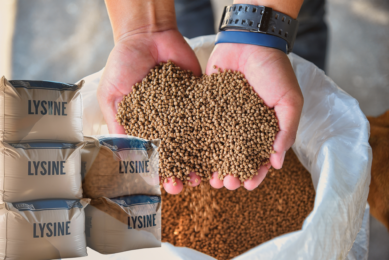Insta-Pro: No need to bake your pet food or fish feed

Dave Albin who is an Applied Nutrition Technologist at Insta-Pro, has conducted some in-depth research into the drying aspect through an extruder.
Insta-Pro’s new Medium Shear Extruder allows for the production of dry, shaped feed and food products – especially targeting high-quality manufacturers of dry pet food and fish feed for aquaculture.
The Medium Shear Extruder has several distinct characteristics that help producers generate the results they need. First, a little background – Insta-Pro has a long history of producing excellent dry extrusion systems that are known as HTST (high temperature, short time). The product being extruded is exposed to high temperature (260-350oF) cooking for only a few seconds, and is thermally (heat) processed for a total of only 15-20 seconds, resulting in a product typically containing 16-20% moisture post-extrusion. As there is no requirement for additional steam or moisture injection into the barrel for cooking, this is known as “dry” extrusion. The new Medium Shear Extruder will have these characteristics.
Extrusion can be dry or wet, and this depends on the moisture requirements of the extrusion process. Standard wet systems typically have 22-28% residual moisture in the product, and even high moisture (> 40%) extrusion has been developed.
While wet and high moisture extrusion offer some unique capabilities, the fact remains that the extruded product, with its high moisture content, must be dried for preservation. Spoilage microorganisms and pathogenic bacteria require water to survive and thrive, and so, unless other methods of preservation (such as freezing) are used, the product will degrade very quickly. So, extruded products are dried, and the more moisture present at the end of extrusion, the more they must be dried.
How is this accomplished? Typically, large, thermal drying systems are employed. Extruded product is slowly moved on a conveying system through heated (as much as 200oC) dryers.
This approach has several drawbacks. Expensive drying equipment is now required to have any salable product. Also, the equipment must be maintained, calibrated, and even heating must be verified to ensure that a uniform final product is produced. The dryers are typically quite large and consume a lot of space in the plant, either vertically, horizontally, or both. Cleanliness must be maintained to avoid potential food safety concerns – this is not easy when considering that the product is conveyed through a large, enclosed structure. Finally, a lot of energy is required to constantly run the dryer. The more moisture present after extrusion results in the need for more drying, and therefore, more energy will be required.
It is also important to notice that even though we are taking about equipment for making nutritious, quality products for animals, we haven’t discussed the effects of thermal drying on nutrients yet.
Researchers at Wageningen University in the Netherlands studied the effects of several factors on nutrients in dry dog food (Tran, 2008). The effect of drying temperature was one of the factors. The researchers reported that when drying dog food (beginning at 30% moisture) and using different temperatures and drying times to achieve the same finished product moisture levels in two sizes of dog food, several changes were noted.
With smaller (4 mm) sized dog food, elevated drying temperatures reduced concentrations of some amino acids (critical building blocks of protein), including lysine and reactive lysine, which indicates reduced nutrient availability resulting from the Maillard reaction. When drying temperatures reached 200oC, lysine was reduced by nearly 18%, while reactive lysine was reduced by 27%. Also, with 4 mm dog food, the amount of unsaturated fatty acids (nutritionally-important components of dietary fat) was reduced, while saturated fatty acid levels were increased, at 200oC drying. The authors noted that this could indicate fat oxidation, or deterioration of the dietary fat. With larger (8 mm) dog food, reactive lysine was also reduced with heating for drying, but to a lesser amount compared to the small (4 mm) dog food. This is of interest because the authors noted that the smaller dog food required more drying time to achieve the same moisture level as the larger dog food.
Therefore, drying time is also an important factor when determining the effects of using heat to dry dog food. It’s also interesting to note that several key nutrients were not measured in this study (which is common of nutrition experiments), for example, the heat-sensitive vitamins.
So, in conclusion, manufacturers of high-quality, dry, shaped products (such as dry pet food and fish feed) now have available a Medium Shear, dry extrusion solution, which does not require excessive drying of the product and the concerns that come with it.
Literature Cited:
Tran, 2008. Extrusion processing: effects on dry canine diets, Ph.D. Thesis, Wageningen University and Research Centre, Wageningen, the Netherlands.











